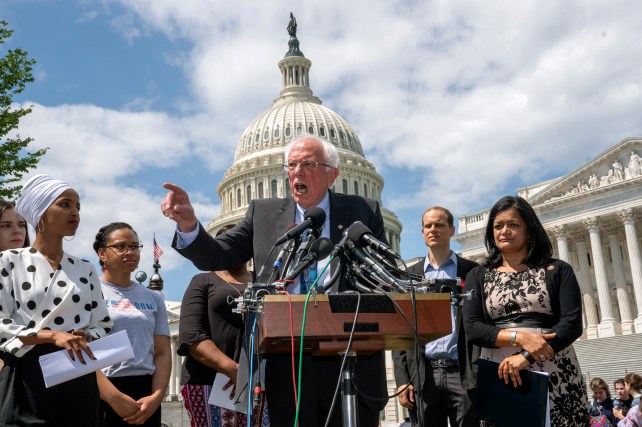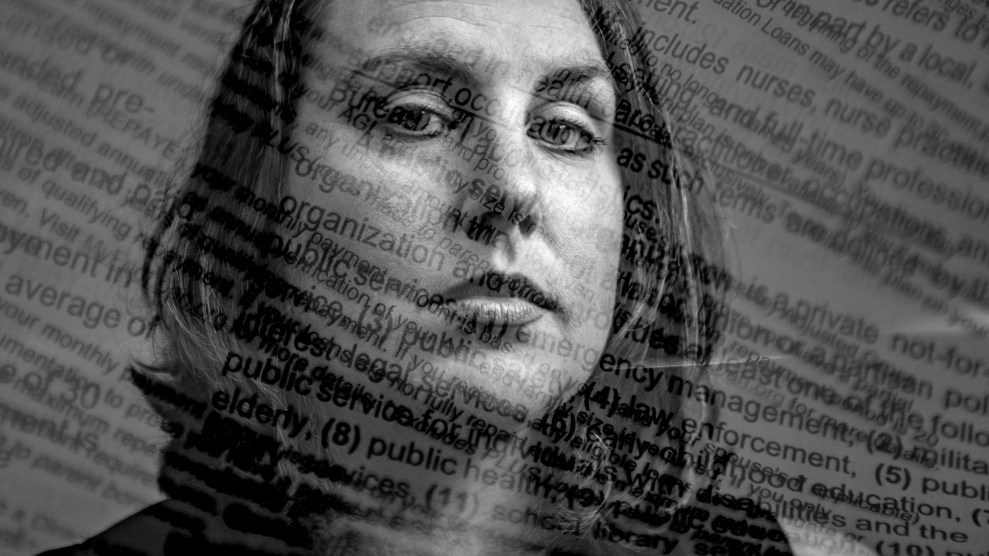
Mother Jones illustration; Getty
Last April, the socialist magazine Jacobin had a message for its favorite presidential candidate: “As President, Bernie Sanders Should Cancel All Student Debt.” The secretary of Education, the magazine argued, could wipe out most of the $1.6 trillion in outstanding college loans “with the stroke of a pen.” As his reward, Jacobin predicted, Sanders would win “the lifelong loyalty” of millions of young Americans.
But it was Elizabeth Warren who first answered that call. Later that month, she unveiled a proposal to cancel up to $50,000 in student debt for borrowers who earn up to $250,000 per year. The plan would use an income-based sliding scale to determine how much assistance each person gets, a formula that would eliminate 40 percent of all student debt and provide relief to 95 percent of the country’s 45 million borrowers. Jacobin criticized the plan for its means-tested eligibility requirements but still credited Warren for taking the lead. Her proposal “isn’t perfect, but it’s the boldest so far,” the magazine said. “Bernie Sanders should take notice.”
He did. In June, the Vermont senator teamed up with Rep. Ilhan Omar to introduce a bill that went beyond Warren’s: It would cancel all student debt, for all borrowers, “no exceptions, no questions asked,” Omar said.
Wiping out student debt has become an increasingly central part of the 2020 debate. That’s a radical change from four years ago, when none of the Democratic contenders—not even Sanders—embraced it. This time around, polls have shown support for the idea, as activists have worked to transform the public image of the student debtor from lazy, handout-hungry Millennial to hardworking victim of predatory banks and bad government policy. Many of this cycle’s more moderate Democratic hopefuls have spoken out against wide-scale loan forgiveness, but even Pete Buttigieg—who’s spent the primaries criticizing Sanders’ and Warren’s proposals for tuition-free college—has a plan to cancel debt for students who attended for-profit colleges. Meanwhile, President Donald Trump, worried that the progressive debt relief plans could prove popular, has reportedly pushed aides to come up with their own solution to the issue.
This remarkable shift in the political conversation didn’t come out of nowhere. It has its roots in a tiny group of experts, activists, and donors who have worked with both Sanders and Warren to turn a nascent, left-wing pipedream into a plank of presidential platforms. But exactly how these proposals found their way into those platforms illustrates the dramatically different visions that the two leading progressives have brought to the campaign. For Warren, it’s about wonky expertise—the use of carefully calibrated policies to protect society’s most vulnerable from predation. For Sanders, it’s about channeling the energy of the left into sweeping policies that upend unjust systems in their entirety.
How did we end up in this place, where 13 percent of Americans owe a collective sum rivaling the GDP of Russia—an amount so large that it’s forcing young people to delay buying homes and having children? The root of the problem, of course, is the cost of college. Beginning in the 1980s, state governments began reining in their funding for higher education, causing the cost of attendance at four-year public schools to more than double between 1985 and 2015. Existing federal aid programs couldn’t keep pace, and in 1992, Congress established a new loan program to address that—one with generous borrowing limits and interest that began accruing immediately. As more middle-class families began to take out loans, the 2005 bankruptcy reform bill—which Joe Biden championed and Warren and Sanders opposed—made it nearly impossible for them to extricate themselves from ruinous loan payments.
Then 2008 arrived, and nearly 30 million borrowers ran straight into the buzzsaw of the financial crash. Students graduated into a dismal economy with few jobs available to pay off their loans. Some chose to weather the storm by attending expensive graduate programs that added five or six figures to their debt. States, meanwhile, responded by slashing higher education funding even further.
The 2008 Democratic presidential candidates put forth modest solutions to the quickly escalating problem. North Carolina Sen. John Edwards proposed one free year of college for “qualified students” on the condition that they “stay out of trouble.” Barack Obama suggested small increases to Pell Grants, a federal program for low-income students—a promise he made good on in his first term as part of broader reforms to federal student loan programs. His focus, however, remained on bailing out the banks.
Some activists deemed that response insufficient. In 2011, Strike Debt, an offshoot of the Occupy Wall Street movement, undertook an unsuccessful effort to get one million borrowers to stop paying back their loans. A spinoff effort called Debt Collective launched its own debt strike with 15 students who had attended Corinthian Colleges, a for-profit chain. The Consumer Financial Protection Bureau—the watchdog agency that Warren first conceived of—later won a lawsuit alleging that Corinthians had defrauded students with predatory recruitment practices, falsified employment statistics, and risky loans.
Around this time, an unlikely pair stumbled onto the growing crisis: Mary and Steven Swig. The couple is part of the Bay Area’s oldest real estate dynasty, which had, at various points, owned iconic San Francisco landmarks, such as the luxury Fairmont Hotel chain. Mary, now 77, built a silk importing and lingerie business that was beloved by Oprah. Her husband, also 77, stepped away from the family business to found a graduate school offering public affairs and business degrees oriented around progressive values.
When I met the two of them—over a video call from their home in San Francisco’s tony Pacific Heights neighborhood—the couple’s casual sweatshirt ensembles betrayed little of their moneyed origins. The only real sign of their influence appeared on the massive coffee cups they were holding, which had a photograph of House Speaker Nancy Pelosi on them. “This is from our nephew, when he got a job with Nancy in Washington,” Steven explained. The extended Swig family is familiar to Democratic operatives as reliable mega-donors, and Mary and Steven are no exception. They’ve contributed at least $2.7 million to federal Democratic efforts since the early 1980s, and Steven serves as Pelosi’s campaign treasurer. (They have also donated to Mother Jones.)
Neither Steven nor Mary ever had student debt. They both attended the University of California, Berkeley, in the 1960s and paid no more than $175 per semester, in activity and health care fees. The issue crossed their radar when their daughter Samantha announced that she planned to use an unexpected inheritance from her grandfather to pay off a friend’s six-figure student loan debt. Mary recounted the tale to her company’s employees, some of whom received substantial sums of money from the Swigs to help them to pay for their children’s college. “I said, ‘Well, isn’t it wonderful? I’m so excited that none of you guys have to worry about student debt for your kids,’” Mary recalled. “Well guess what? They all did. It wasn’t enough.”
The problem became the Swigs’ obsession. “We wanted student debt cancellation to become a mainstream thought in America,” Mary said, something she and her husband saw as a moral imperative. In 2014, they threw themselves into the project during a yearlong fellowship at Harvard, where they worked alongside faculty and students in the law school examining which avenues might be available for debt cancellation. While in Cambridge, they met with Warren, then in her second year on Capitol Hill, and pitched her their vision in the senator’s home. “She was very, very excited about it and gave us access to her entire office,” Mary recalled.

Mary Swig, left, and Steven Swig with Christine Pelosi, the daughter of House Speaker Nancy Pelosi, at the 20th anniversary celebration of the Giffords Law Center in 2013.
Giffords Law Center
Warren was already well-versed on the issue, thanks to her background as a personal bankruptcy expert. Her 2004 bestseller, The Two-Income Trap, predicted the imminent crisis and blamed it on “conservative policymakers” who were “making more loans available to families,” comparing the system to “throwing rocks to a drowning man.” Her first bill in Washington aimed to cap student loan interest at the same low rate that the Federal Reserve offered to banks, and she had worked closely with Student Debt Crisis, another activist group, on legislation that would allow borrowers to refinance their existing loans.
By the time the Swigs approached her, Warren had begun working with the defrauded Corinthian student activists to pressure the Obama administration to forgive their loans through a provision known as “borrower defense,” which permits debts to be absolved if students have been cheated by their schools. Warren was partly successful: Obama’s Education Department cancelled debts for 30,000 students by the time he left office. (That progress has stalled under Trump.)
But Warren’s team soon realized the problems went far beyond for-profit schools. The terms of the loans, their interest rates, and the behavior of servicers and debt collectors all raised concerns. “The more we dug, the more unfairness we’d find,” recalled Julie Margetta Morgan, who was Warren’s top staffer on the issue. (Morgan recently joined Warren’s presidential campaign.)
Meanwhile, Demos, a progressive think tank with strong Warren ties—her daughter Amelia chaired its board until last year—conducted research into how the student loan system helped exacerbate racial inequality. A 2015 Demos paper concluded that young, black households were far more likely to have student debt than their white peers, a result of higher financial need and a lower likelihood of completing their degrees. The researchers argued that the racial wealth gap could be decreased if student loans held by families earning $50,000 and under were fully cancelled. Anything less than that wouldn’t make much impact, according to their study; anything more risked widening the wealth gap, because children from wealthier white families attend college at disproportionately high rates.
That spring, Sanders had hit the presidential campaign trail with his own bold idea to tackle college affordability. “I want every kid in this country who has the ability to be able to go to a public college or university tuition free,” he said in one debate. Sanders also proposed lowering interest rates on existing student debt, but he stopped far short of calling for those loans to be wiped out. Among White House contenders that year, only Green Party candidate Jill Stein embraced student debt forgiveness.
To move the issue forward, the Swigs realized they would need to demonstrate that cancelling student debt was both feasible and beneficial. And they were determined to push for universal cancellation, not the means-tested solution Demos had advocated. “When you really get into it, all of the means testing is testing the middle [class] against the lower-middle,” Steven told me. In 2017, they commissioned their own report from a team that included economist Stephanie Kelton, an adviser to Sanders. Kelton is a proponent of Modern Monetary Theory, a controversial idea that holds that since the government can print its own money, there is little danger posed by massive increases in government spending.
The study, published by the Levy Economics Institute of Bard College in February 2018, concluded that cancelling all of the outstanding debt, then $1.4 trillion, would have a “meaningful economic stimulus” with only “moderate effects on the federal deficit.” Gross domestic product, it predicted, would increase by up to $108 billion per year, or half a percent of 2018’s $20.5 trillion GDP. Inflation and interest rates would rise a bit after cancellation happens, but “not to problematic levels,” and would taper off after the first few years, Kelton told me. “So in other words, where’s the problem?” she said. (Other economists disagree.)
In 2018, the Swigs also endowed a fellowship for Morgan, the former Warren Senate staffer, at the Roosevelt Institute. Morgan and labor economist Marshall Steinbaum published several papers that put numbers behind a feeling that many borrowers had expressed: Student debt was a crushing burden, even for those who were able to pay their bills on time. This was particularly true for people of color. Even worse, the education those loans purchased hadn’t actually increased earnings.
Data in hand, the Swigs began shopping their vision around Capitol Hill as the midterm elections neared. An obvious stop, given Kelton’s involvement, was Sanders’ office. But he hesitated to sign on, according to people familiar with his thinking at the time. Sanders agreed that cancelling debt made sense, but his focus had been on the free-college side of things, which had evolved from a campaign platform into his 2018 College for All Act. Besides, Sanders reasoned, student debt had always been Warren’s thing, and he didn’t want to step on her toes. As he hit the campaign trail for a second go at the presidency, he told early crowds that “perhaps” he could cancel student debt.
The Swigs tried Warren’s office, too, where they were similarly met with reservations. Warren had already begun outlining her own vision for debt cancellation, with contours that more closely resembled Demos’ 2015 whitepaper that advocated for a means-tested approach. Throughout the primary, Warren would focus her trove of policy proposals on addressing racial inequality, and this plan would be no exception. Whatever Warren came up with, it would need to cancel as much debt as possible while also reducing the racial wealth gap.
In March, at the recommendation of Demos, the campaign reached out to Tom Shapiro, a sociologist at Brandeis University who worked on the Demos report, with a simple request: “How much debt can we cancel in a design that also closes the racial wealth gap?” Shapiro recalled. She wanted a proposal that cancelled all debt for at least 75 percent of borrowers. It was the task of Shapiro and the team he assembled to determine the income thresholds eligible for cancellation and how much relief each borrower should receive.
Warren was an eager collaborator, reviewing proposals on plane rides between Cambridge, DC, and the campaign trail, Shapiro said. They settled on a program that would offer full debt cancellation—up to $50,000—to anyone making $100,000 or less. People with incomes above $100,000 but below $250,000 would see a smaller proportion of their debt eliminated. Warren released her plan at the end of April, paired with a free college program and a proposed investment in minority-serving institutions to “help end racial disparities in college enrollment and resources.” It would all be paid for by her “ultra-millionaire” tax on households with assets greater than $50 million.
Meanwhile, the Swigs found a new ally in Omar, who during her 2018 campaign had openly discussed her own struggles with student debt. A Somali immigrant, she had attended college in her late twenties while raising two small children. When she entered Congress, she knew this was a bill she wanted to work on—and she wanted to do it with Sanders, who shared her commitment to bold, universal solutions.
In early 2019, Omar’s office began working with Kelton and making overtures to Sanders’ office, even as he remained noncommittal. Once it became clear that Warren wasn’t going to universally cancel all debt—and that a proposal to do just that, spearheaded by Omar, was moving ahead—Sanders got on board.
On a late June Friday, Sanders joined Omar and Rep. Pramila Jayapal (D-Wash.), the House sponsor of his free college legislation, to discuss how they’d roll out the proposals together. Eager and wide-eyed, Sanders wanted to talk about the messaging Omar had planned: What would Omar say when critics claimed she’d be helping rich kids? People who take out student loans aren’t wealthy, Omar said, according to sources familiar with the conversation. What about when people say it costs too much? Omar cited the Levy report, telling Sanders that cancellation would be an economic stimulus that paid for itself. (The Sanders Senate office and campaign did not return requests for comment.)
In a Capitol Hill press conference the following Monday, Omar and Sanders introduced their legislation, paid for by a tax on Wall Street speculation. “It is time to end the absurdity of sentencing an entire generation—the millennial generation—to a lifetime of debt for the ‘crime’ of doing the right thing: getting a college education,” Sanders wrote in an op-ed.

Omar, Sanders, and Jayapal introducing their student debt legislation
J. Scott Applewhite / AP
The wonks behind Warren’s plan panned Sanders’ proposal. “It’s a disaster for equity,” Shapiro told me, arguing that bailing out those at the high end of the income scale would basically just hold the racial wealth gap steady. But that argument took a hit in July when Steinbaum, the Roosevelt Institute economist, published a report suggesting that Sanders’ plan would actually do more than Warren’s to close the wealth gap. The Warren camp says it remains confident that the Massachusetts senator’s proposal would work as intended. (Other experts chalked up the competing findings to different data sets on a quickly evolving, hard-to-measure topic.)
The Swigs, meanwhile, were disappointed that Warren, their chief Senate ally, had gone the means-tested route. “It basically says that a couple making $100,000 a year is rich because that’s where her cut-off point is [for the maximum $50,000 cancellation],” Mary said. “I’m very surprised.”
As the campaign has worn on, Sanders and Warren have continued to litigate the daylight that exists between their proposals. Warren, her campaign noted in a statement, “is the only candidate who has proposed using executive action” to cancel student debt, rather than waiting for Congress to cooperate. And she remains focused on race. “African-Americans are more likely to have to borrow money to go to school, more likely to borrow money while they’re in school, and have a harder time paying it off,” Warren said during the December debate. Sanders countered, “I believe in the concept of universality, and one of the crises in America today is [that] people are sick and tired of filling out forms.”
But those contrasts can often seem insignificant compared to the gulf that exists on the issue between the two progressives and their Democratic opponents. Biden, Buttigieg, Amy Klobuchar, and Michael Bloomberg have all declined to support broad student debt relief.
That hasn’t stopped Mary and Steven Swig from backing the former vice president; the couple held a fundraiser for him in December. As our conversation ended, I mentioned Biden’s platform, his work on the 2005 bankruptcy bill, and the activists who hold him responsible for that law’s onerous student debt provisions. The Swigs pushed back, explaining that Biden himself had carried nearly $300,000 in debt from putting his children through college. “He’s not with us,” Mary explained, referring to the couple’s loan forgiveness push, “but he is with the issue.”
That was in September. This week, over email, I asked Mary if Biden was any closer to embracing the idea. “No luck yet,” she said, “but we’re still working on it.”
Image credit: Mother Jones illustration; Getty, Chip Somodevilla/Getty, Scott Olson/Getty













